Chickpea or Chickpea (Cicer arietinum) is a legume plant and belongs to the Fabaceae family. Chickpea is called known as Bengal gram. Adequate and balanced nutrition is necessary for high grain production. Chickpea is an annual plant widely grown for its nutritious seeds. The phosphorus, potassium, and sulfur requirements are similar to peas or lentils.
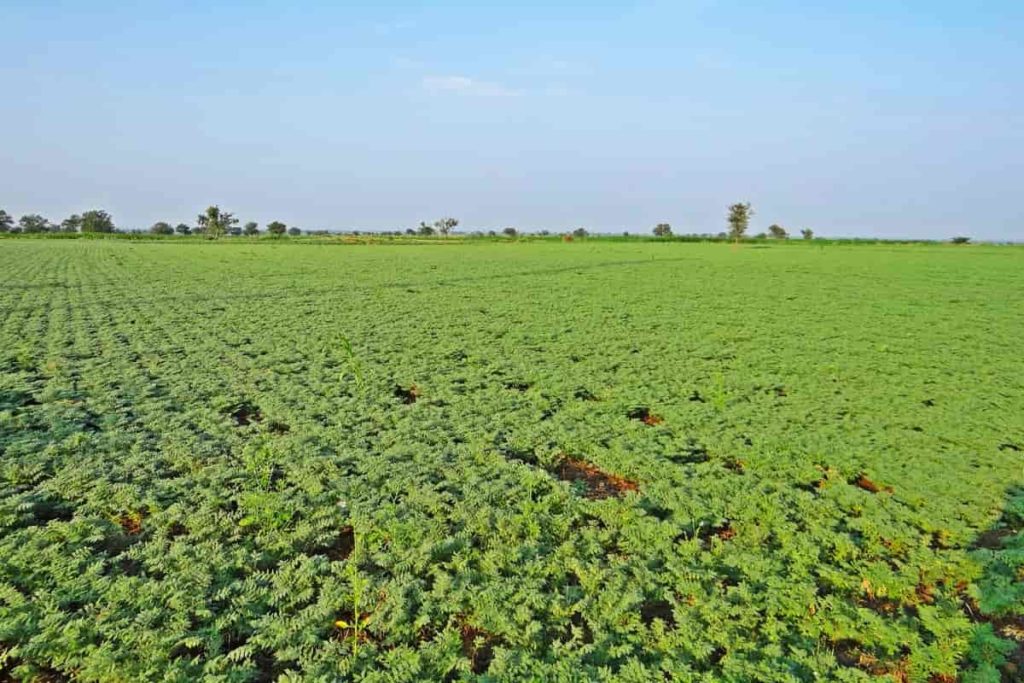
A well-inoculated crop should not require nitrogen fertilizer, provided appropriate Rhizobium inoculants are used and improved nitrogen accuracy. Suppose nitrogen fixation is not enhanced due to unfavorable growing conditions (such as relatively dry seedbeds). In that case, Chickpea may benefit from a lower rate of starter N in a few years. Let’s find out the best fertilizer for Chickpea/Bengal Gram below.
High rates of starter nitrogen
The high rates of starter nitrogen (removed from seed) application is helpful to improve plant growth. Excessive use of nitrogen fertilizers, or high nitrogen levels available in the soil, reduces nitrogen accuracy and can delay maturation. The soil test will provide guidelines for fertility requirements.
Fertilizer requirement (kg / acre)
| Crops | Urea | SSP | Muriate Of Potash |
| Desi | 13 | 50 | Apply as per soil test result |
| Kabuli | 13 | 50 | Apply as per soil test result |
Best fertilizer for Chickpea/Bengal Gram
Essential nutrients for Chickpea
Nitrogen
- Nitrogen fertilizers meet nutritional requirements; this is the key to crop growth. Nitrogen is an element of development. Knowledge of its dynamics in the soil allows us to improve performance while applying this element. Combining sulfur, microelements, and nitrogen improves their assimilation efficiency by synergy (S, Zn, Mg).
- Nitrogen helps determine plant growth and development.
- Rhizobium sp., associated with the presence of, which fixes this nutrition.
- Chick pea plays an essential role in improving soil fertility by fixing atmospheric nitrogen. It meets 80% of its nitrogen (N) requirement through symbiotic nitrogen fixation and can weigh up to 140 kg N per hectare from air. It releases enough residual nitrogen for later crops and adds abundant organic matter to maintain and improve soil health and fertility. Due to their deep tap root system, lentils can withstand drought conditions by extracting water from deep layers in the soil profile.
- A small starter dose of 15 to 25 kg N per hectare stimulates early Chick pea development. Nitrogen was profitable for rain-fed Chick peas up to 30 kg per hectare.
In case you miss this: Chickpea Seed Germination, Time, Temperature, Procedure
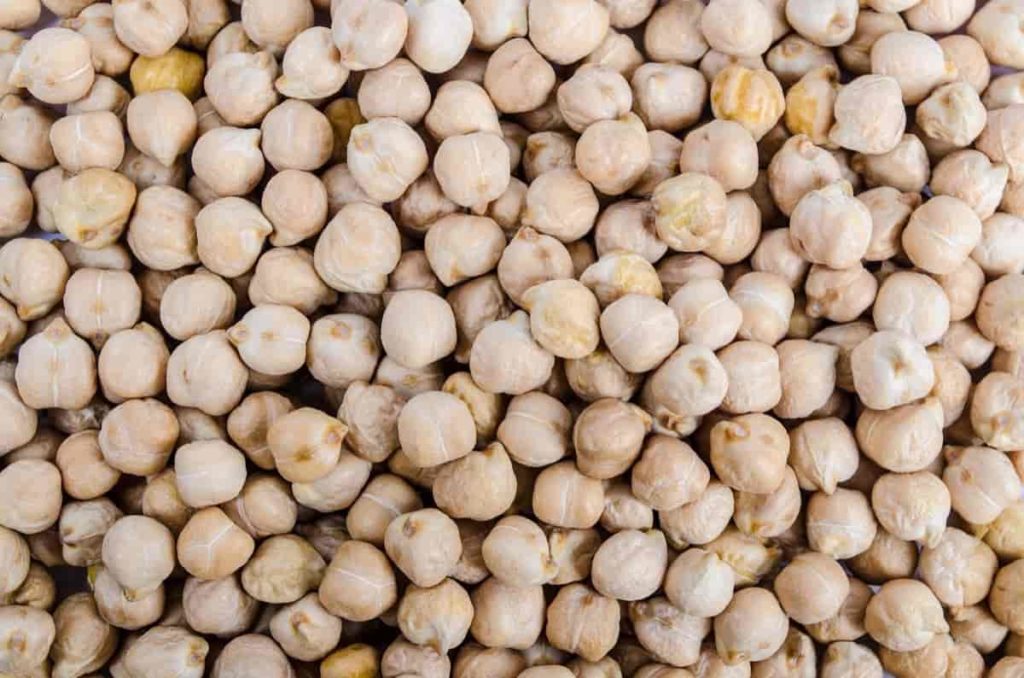
Common symptoms of nitrogen deficiency
- Yellowing of older leaves than upper leaves
- Pink stem at the base of the plant
- A thin reddish-pink border around the serration of the leaflets
- Necrosis or abscission in primary leaves. In adult leaves, a light green color turns yellow.
Nitrogen fixation by Chickpea
The nitrogen fixed by Chickpea varies from 1 to 141 kg per hectare, depending on the crop used.
Factors affecting N fixation
- Crops vary in the amount of N fixed.
- Excess moisture and lack of humidity can affect nodulation.
- Nodulation decreases with the increasing use of nitrogen.
- The density of mulching and sowing affects nodulation.
Phosphorus
Pulses crops need phosphorus for healthy growth, which helps in early maturation and nitrogen fixation. Chickpea requires a lot of phosphorus (P). Phosphorus plays an essential role in metabolism processes like energy transfer, respiration, and photosynthesis. Therefore, the plant requires a maximum P from the initial seed stage to maturity.
Phosphorus stimulates the growth of the root system, stem, flower, and some pods and grains. Its use as a basal dressing increases the weight of Rhizobium sp. Nodules. The most effective use is when it is soluble in water and ammonium citrate. The use of phosphorus varies from 17 to 54 kg P per hectare of land, depending on the phosphorus available in the soil.
Common symptoms of Phosphorus deficiency
- Dark green stunned plants
- Reddish purple stems
- The reddish-purple margin on the upper edge of the lower leaves and the upper surface
- The leaves turn pale and turn yellowish-green or buff green
- Stunted growth, thin stems, and small internodes.
- Small dark green upper leaves. Yellow lower leaves with necrotic edges. Suppose the deficiency is severe, there is a delay in flowering, reduction in the number of seeds per pod, and early defoliation.
In case you miss this: Chickpea Cultivation Income (Bengal Gram), Project Report
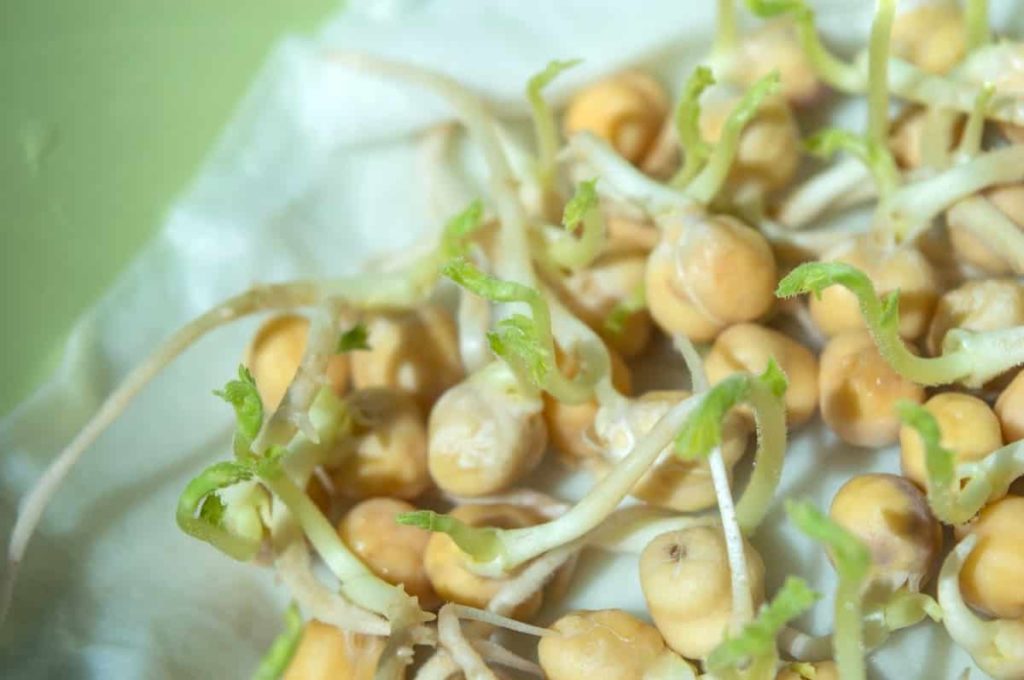
Potassium
- Favors carbohydrate synthesis and protein synthesis
- Activates photosynthesis and controls reserve substances (increases resistance to cold and drought)
- Stimulates nodules formation and root system development
- To potassium application in soils with high levels of available K. If soils are low in available potassium, about 17 to 25 kg K per hectare application is recommended.
Common symptoms of potassium deficiency
- Yellowing edges of the plant leaves
- Margins and tips of lower plant leaves show chlorosis
- Tips of leaflets show brown color necrotic patches and die
Magnesium
- Intensifies photosynthetic activity
- Protects from burning by the sun
Symptoms of deficiency – Chlorosis with the appearance of brown color spots in the moments near flowering.
Sulfur
- High demands
- In favor of bearing fruit
- Regulates nitrogen availability and activates phosphorus, potassium, and soil micro-elements.
- It improves soil microbial activity.
Symptoms of deficiency – Uniform chlorosis in the lower leaves that extends to the smaller leaves.
Iron
Symptoms of deficiency – In calcareous soils with high pH, chlorosis due to waterlogging due to unavailability of iron. Chlorosis at the terminal on three or four newly formed leaves. If severe, the affected leaves wither. The rachis withers from head to toe to the base. Chickpea shows specific symptoms of iron deficiency when dropped on soils rich in calcium carbonate. This deficiency can be treated with 0.5% ferrous sulfate foliar spray.
NPK fertilizers
Complex NPK fertilizers are applied during sowing time to balance soil nutrients: primary, secondary, and micronutrients. The correct composition and balance will be used according to the soil content, keeping the crop requirements and expected yield.
In case you miss this: Chickpea Farming (Bengal Gram/Chana) Guide
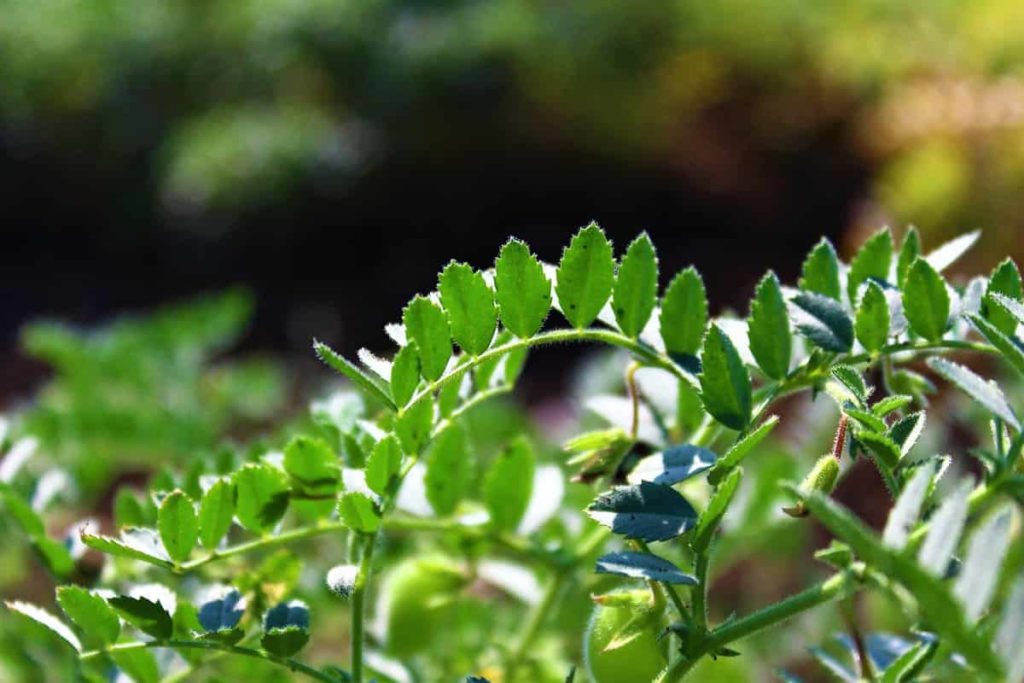
Fertilizer application
- About 15-20 kg N, 40 kg P2O5, 20 kg S, 1.0 kg ammonium molybdate, and 5 tons FYM / hectare
- Spray 2% urea / DAP in the flowering stage (70 DAS)
Apply fertilizers basally before seed sowing.
- Rainfed Chick pea – 10:40:20 NPK (kg / ha)
- Irrigated Chick pea – 20:60:40 NPK (kg / ha)
Foliar spray – Nutrients are applied in dilute solution on standing crops on plant leaves. The spray solution’s minimum safe concentration and frequency depend on the yield, maturity stage, spray season, spray wetting, and application quality. Generally, it is recommended to spray 1 to 3 sprays of micronutrients and 3 to 6 sprays of macronutrients and moisten the leaves in each spray.
Micronutrients
- The use of molybdenum increases grain production.
- Combining copper, manganese, and zinc also affects the crop.
Organic fertilizers
The use of organic matter like animal manure, yard waste, sewage sludge, human waste, food waste, and compost has long been recognized in agriculture as beneficial for plant growth, production, and maintaining soil fertility. New methods of using organic modifications in agriculture have proved to be an effective tool for improving soil structure, increasing soil fertility, and increasing crop yields.
In case you miss this: District Wise Crop Production in Andhra Pradesh: Major Crops in Andra Pradesh
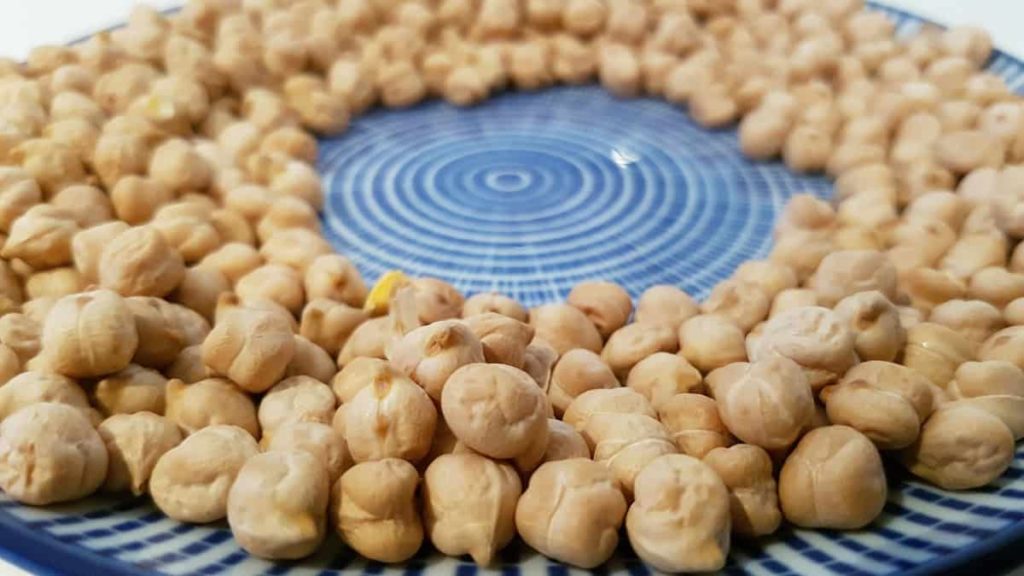
Organic farming has been recognized for helping to increase crop yields and ensure quality crops. It includes using agricultural wastes, urban wastes, and industrial wastes as nutrients for crops. The traditional method of composting organic waste has been known for many years. Still, new ways of thermophilic composting have recently become very popular in treating organic waste as they eliminate some of the harmful effects of organic waste in the soil.
With a constant increase in the vermicompost dose from 0 to 3 and 2 tonnes per hectare, the grain yield has increased, the best amount. Chickpea production with various nutrients improved plant growth and production characteristics—the importance of using nutrients from different sources to achieve high productivity of Chickpea. Organic manure is applied 30 days before sowing. At 50% flowering, liquid organic manure, Panchgavya 3%, vermiwash 10%, cow urine 10% are used.
The use of organic fertilizers enhances the soil nutrients and improves the physical and biological soil conditions. So, integrating chemical fertilizers and modifying locally available soil is the best way to achieve high fertilizer application efficiency and economic potential.
Fertilizer application method
As a fruit crop, Chickpeas meet most of their nitrogen requirement (approximately 75%) through symbolic nitrogen fixation after sowing, which works effectively for three to four weeks. Soils with low organic matter can require 20-25 kg nitrogen per hectare, as does a starter that can meet plants’ needs before nodules are formed.
In case you miss this: District Wise Crop Production in Maharashtra: Major Crops in Maharashtra
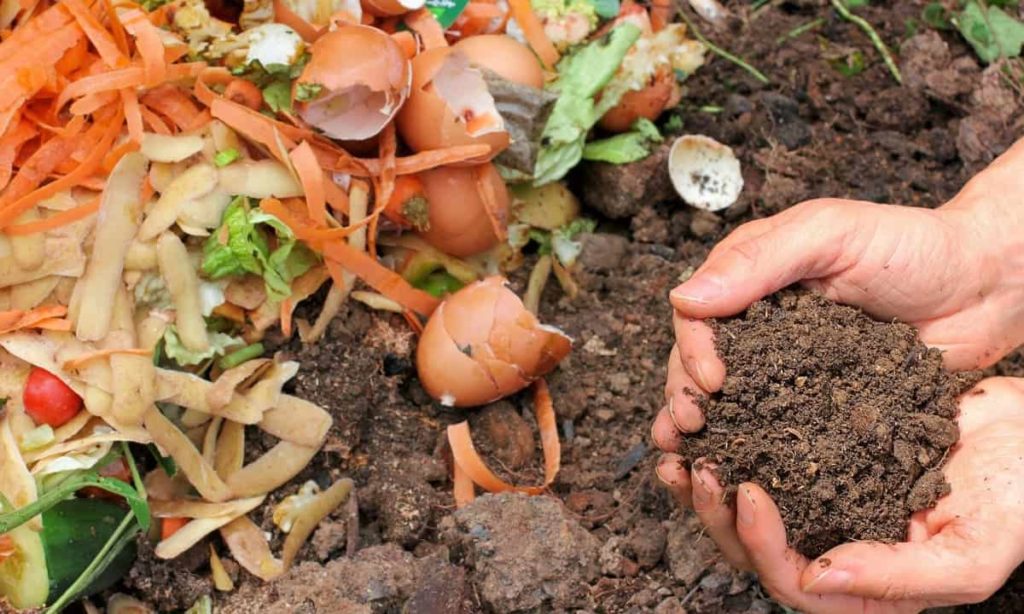
In addition to nitrogen, pulses respond well to phosphorus use if the soil is deficient in phosphorus. If both nitrogen and phosphorus supply is required, apply diammonium phosphate (18-46-0) evenly at 100 to 150 kg/hectare before plowing the last disc. Potassium requests have been inconsistent. It is best to put all the fertilizers in the skins to about 7-10 cm.
- How to Make Houseplants Bushy: Effective Tips and Ideas
- Innovative Strategies for Boosting Coconut Pollination and Yield
- Pollination Strategies for Maximum Pumpkin Yield
- The Complete Guide to Chicken Fattening: Strategies for Maximum Growth
- Natural Solutions for Tulip Problems: 100% Effective Remedies for Leaf and Bulb-Related Issues
- Revolutionizing Citrus Preservation: Towards a Healthier, Greener Future
- Natural Solutions for Peony Leaf and Flower Problems: 100% Effective Remedies
- Maximizing Profits with Avocado Contract Farming in India: A Comprehensive Guide
- Natural Solutions for Hydrangea Problems: 100% Effective Remedies for Leaf and Flowers
- The Ultimate Guide to Choosing the Perfect Foliage Friend: Bringing Life Indoors
- From Sunlight to Sustainability: 15 Ways to Use Solar Technology in Agriculture
- The Ultimate Guide to Dong Tao Chicken: Exploring from History to Raising
- The Eco-Friendly Makeover: How to Convert Your Unused Swimming Pool into a Fish Pond
- Mastering the Art of Delaware Chicken Farming: Essentials for Healthy Backyard Flocks
- 20 Best Homemade Fertilizers for Money Plant: DIY Recipes and Application Methods
- How to Craft a Comprehensive Free-Range Chicken Farming Business Plan
- Brighten Your Flock: Raising Easter Egger Chickens for Beauty and Bounty
- How to Optimize Your Poultry Egg Farm Business Plan with These Strategies
- Subsidy for Spirulina Cultivation: How Indian Government Schemes Encouraging Spirulina Farmers
- Ultimate Guide to Raising Dominique Chickens: Breeding, Feeding, Egg-Production, and Care
- Mastering the Art of Raising Jersey Giant Chickens: Care, Feeding, and More
- Ultimate Guide to Raising Legbar Chickens: Breeding, Farming Practices, Diet, Egg-Production
- How to Raise Welsummer Chickens: A Comprehensive Guide for Beginners
- How to Protect Indoor Plants in Winter: A Comprehensive Guide
- Ultimate Guide to Grow Bag Gardening: Tips, Tricks, and Planting Ideas for Urban Gardeners
- Guide to Lotus Cultivation: How to Propagate, Plant, Grow, Care, Cost, and Profit
- Agriculture Drone Subsidy Scheme: Government Kisan Subsidy, License, and How to Apply Online
- Ultimate Guide to Raising Araucana Chickens: Breed Profile, Farming Economics, Diet, and Care
- Bringing Hydroponics to Classroom: Importance, Benefits of Learning for School Students
- Ultimate Guide to Raising Polish Chickens: Breed Profile, Farming Economics, Diet, and Care
- Ultimate Guide to Raising Australorp Chickens: Profile, Farming Economics, Egg Production, Diet, and Care
- Silkie Chicken Farming: Raising Practices, Varieties, Egg Production, Diet, and Care
- Sussex Chicken Farming: Raising Practices, Varieties, Egg Production, Diet and Care
- Homemade Feed Formulations for Livestock: Discover Cost-effective Starter to Finisher Feed Recipes
- 20 Best Pig Weight Gain Supplements: Top Swine Weight Gain Formulas
- Ultimate Guide to Elderberry Farming: Propagation, Planting, Yield, Cost, and Profit